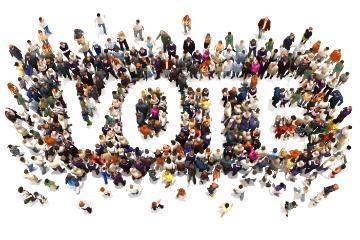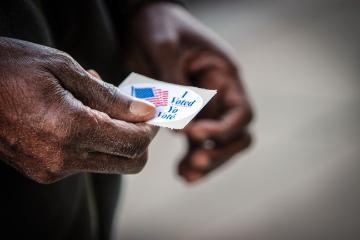
Yael Kidron is the director of Character Education and Kristy Esparza is the program manager of Character Education at the Markkula Center for Applied Ethics. Views are their own.
The all-time high spending of $5.2 billion on the 2018 midterm elections may have succeeded in setting a new midterm turnout record. High early voting rates may also make a positive change to the historically low turnout of young voters.1 While these efforts can promote greater representation and diversity of voices in the elections, the process should have started much earlier. When public and private school students in the United States reach their senior year in high school with an interest in civic participation, schools will accomplish an essential educational objective that can both promote democracy and save taxpayer dollars.
To foster pro-voting attitudes, educators can start with school-age youth. As an ingenious experiment has recently found, voting is influenced by one’s self-perceptions and values. Researchers from Stanford University and Harvard University designed a study that examined the implicit influence of suggestive language on voting behavior.2 Study participants were more likely to vote after completing a questionnaire that referred to their voting identity (e.g., “How important is it to you to be a voter?”) instead of their voting behavior (e.g., “How important is it to you to vote?”). The results, which were replicated in California and New Jersey, were the same for participants regardless of their age, gender, ethnicity, level of education, household income, political orientation, or interest in politics and public affairs. These findings send a significant message to the field of character education: Barriers to voting such as being out of state or having limited access to early voting notwithstanding, young people may show higher participation in the elections process if they reflect on their civic values and identity as voters.
Understanding civic responsibilities, such as voting, is part of the National Assessment of Educational Progress (NAEP) framework for civics assessment in Grades 4, 8, and 12. Take for example the eighth-grade assessment. It examines the extent to which students know what purposes a government should serve, the importance of the rule of law, as well as past and present efforts to reduce discrepancies between American ideals and reality. However, in 2014, only 23 percent of the test takers scored at or above proficient level. This low rate has been resistant to change—in 1998, 2006, and 2010, only 22 percent of participants scored at or above the proficient level. NAEP analysts found a positive correlation between student’s perceptions of their civics courses as interesting and test scores. Does that mean that the majority of students find their civics courses boring or irrelevant?
Discussing the elections and their results with students is an opportunity to bring civics education to life, by connecting academics to contemporary issues. From elementary grades through high school, an exploration of voting can be an engaging way for teachers to expand students’ awareness of the rights and responsibilities of citizenship. The excitement before and after the midterms can stimulate more engaged learning.
What Can Schools Do?
Reading aloud picture books to beginning readers can engage children in the elementary grades. There are several quality children’s books that teachers can pick from. The book Around America to Win the Vote: Two Suffragists, a Kitten, and 10,000 Miles (Mara Rockliff and Hadley Hooper) describes the efforts of Nell Richardson and Alice Burke to raise public support of voting rights for women. Lillian’s Right to Vote: A Celebration of the Voting Rights Act of 1965 (Jonah Winter and Shane W. Evans) offers a reflection on the long road to racial equality, beginning with Lillian’s great-great-grandparents who were not allowed to vote and ending with the campaigns for equal voting rights in the 1960s.
Students in the middle grades can discuss the process by which citizens influence the actions of their government and the quality of life of the governed. Real world connections may include making a list of aspects of school life that are influenced by the state and federal government. Middle school students can pose research questions (e.g., “How many African American representatives and senators were included in each Congress from 1870 to the present?”) and analyze historical trends in U.S. elections within and across states.
High school students can take turns in pairs or group quizzing each other’s knowledge of the history and current policies of voting in the U.S. We have prepared a sample quiz. Test your knowledge, and then assign to students.
Test Your Knowledge: Voting and Elections in the United States
- When was the minimum legal voting age lowered from 21 to 18 years?
- 1941
- 1951
- 1961
- 1971
- What Amendment to the Constitution granted women the right to vote?
- The 18th Amendment
- The 19th Amendment
- The 20th Amendment
- The 21st Amendment
- In what year was the Amendment mentioned in Question 2 ratified?
- 1910
- 1920
- 1930
- 1940
- Which legislation was intended to prevent state and local government from inhibiting votes by racial minorities?
- The Fourteen Amendment, which granted African American the rights of citizenship.
- The Fifteenth Amendment, which granted voting rights regardless of race, color, or previous conditions of servitude.
- The Twenty-fourth Amendment, which abolished the Poll Tax Qualifications in Federal Elections.
- The Voting Rights Act of 1965, which prohibits imposing voting laws that disenfranchise racial minorities.
- When could legal aliens (non-citizens who are permanent residents) no-longer vote in the US?
- Since 1914
- Since 1942
- Since 1986
- Since 1996
- What do voters choose in the midterm elections?
- One-third of senators and every member of the House of Representatives.
- One-half of senators and every member of the House of Representative.
- One-third of senators and one-half of the House of Representatives.
- One-half of senators and one-third of the House of Representatives.
- In what year all senatorial elections around the nation were held by popular vote for the first time?
- 1866
- 1878
- 1914
- 1938
- When can state and city mayoral elections take place in the US?
- During the midterm elections.
- During the presidential elections.
- November of any year.
- Any month, any year.
- Which of the following officials has the most influence on the education policy in your state?
- The president
- The US Secretary of Education
- The state governor
- The state school superintendent
- Between 1964 and 2012, the voting rate of 18- through 24-year-olds…
- Increased from 51% to 62%.
- Increased from 51% to 81%
- Decreased from 51% to 38%.
- Decreased from 81% to 12%.
Answer key: 1. d. 2. b. 3. b. 4. c. 5. d. 6. a. 7. c. 8. d. 9 c. 10. c.

In high school, teachers can ask students to re-enact or debate Supreme Court cases concerning voting rights—for example, the 2013 Supreme Court ruling on Shelby County v. Holder, which is summarized below.
Case Study: Shelby County v. Holder
Petitioner: Shelby County, Alabama
Respondents: Eric H. Holder, Jr., Attorney General of the United States and Earl Cunningham, Harry Jones, Albert Jones, Ernest Montgomery, Anthony Vines, William Walker, Bobby Pierson, Willie Goldsmith, Sr., Mary Paxton-Lee, Kenneth Dukes, Alabama State Conference of the National Association for the Advancement of Colored People, and Bobby Lee Harris.
Case summary: The 15th Amendment, ratified in 1870, explicitly provided the right to vote to all citizens regardless of “race, color, or previous condition of servitude.”[3] However, over the next century, several states enacted laws requiring voters to pass “tests” designed to prevent African Americans from voting. After civil rights activism gained national attention in the 1960’s, Congress passed the Voting Rights Act of 1965. Section 2 prohibited the use of voting qualification or prerequisites to voting. Sections 4(b) and 5 of the law required states, counties, and municipalities with a history of race-based discrimination to get pre-clearance from the Department of Justice before implementing new voting laws. The designation of jurisdictions covered by Sections 4(b) and 5 was determined by a “coverage formula.” The coverage formula, first enacted in 1965 and reauthorized in 1970, 1975, 1982, and 2006, was based on a set of factors, which the petitioner argued were not appropriate to modern times and imposed a costly burden on state and counties to demonstrate effects on eligible voters. These factors included: (a) Less than 50 percent of voting age citizens registered or voted in the 1964, 1968, or 1972 presidential elections. And, (b) a prerequisite for voting or registration for voting such as proven ability to read, write, understand, or interpret any matter; knowledge of specified subjects; good moral character; and authentic qualifications by the voucher of registered voters. The petitioner sought a judgment that sections 4(b) and 5 of the Voting Rights Act are unconstitutional.
Decision: In a closely divided 5-4 decision, the Supreme Court ruled Section 4(b) unconstitutional due to the continued use of old election data from 1972 in the coverage formula, which no longer reflected voter turnout in covered jurisdictions. The preclearance process itself was not struck down, but the requirement was essentially nullified without an updated formula which would need to be determined by Congress. The dissenting opinion in this case attributed the improvement in contemporary voter data to the Act itself, with Ruth Bader Ginsburg writing, “throwing out preclearance when it has worked and is continuing to work to stop discriminatory changes is like throwing away your umbrella in a rainstorm because you are not getting wet.”[4]
Public response in favor of the decision: The social circumstances that required Sections 4(b) and 5 no longer exist today.
Public response against the decision: Those states or counties, which were initially singled out using historical data, are now subject to less federal scrutiny. The Department of Justice has noted that some of these jurisdictions had laws that disproportionally affected African American voters including restrictions on early voting and onerous voter identification. While the Supreme Court did not overturn Section 5, in effect, it made it unusable until a new formula becomes available. However, there is public uncertainty about when or whether Congress will approve an alternative formula.
Activity: Prepare a presentation that analyzes the case. State your assumptions about potential ethical implications and include an illustration or a graph.
Related Materials
[1] File, T. (2014). Young-Adult Voting: An Analysis of Presidential Elections, 1964–2012. Washington DC: U.S. Department of Commerce.
[2] Bryan, C., Walton, G., Rogers, T., & Dweck, C. (2011). Motivating voter turnout by invoking the self. Proceedings of the National Academy of Sciences, 108 (31), 12653-12656.
[3] U.S. Const. amend. XV, § 1
[4] Shelby County v. Holder, 570 U.S. 33 (2013) (Ginsburg, J. dissenting).